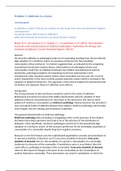Case uitwerking
Problem 5. Addiction is a choice
- Instelling
- Maastricht University (UM)
GGZ2029. Addiction. Problem 5 uitgewerkt: Addiction is a choice. De aantekeningen uit de tutorial zijn met groen toegevoegd. Voor alle taken, zie de bundel.
[Meer zien]




